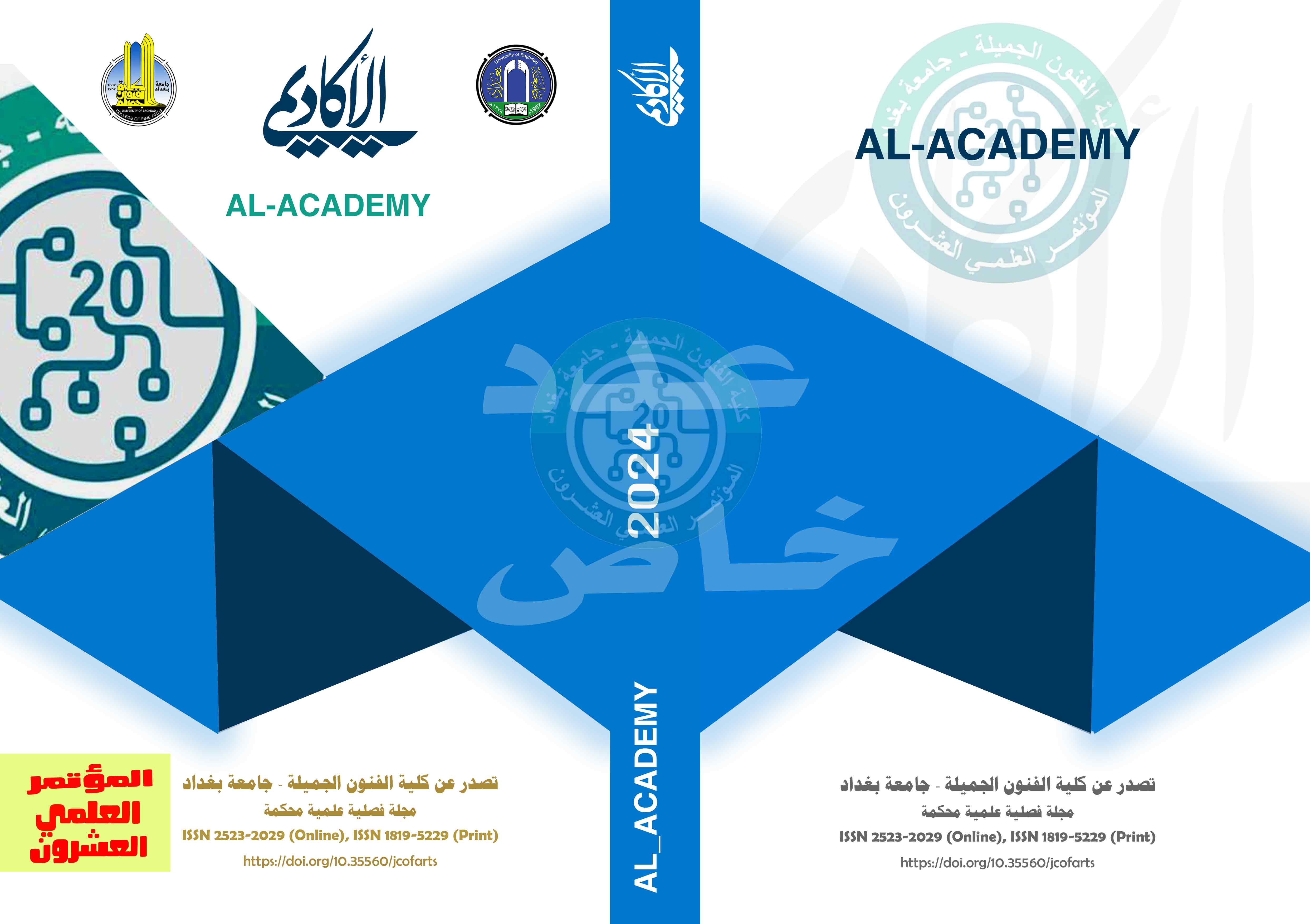Color Enrichment to Use of Plant Leaves in Eco Printing "An Applied Study"
DOI:
https://doi.org/10.35560/jcofarts1414Keywords:
Environmental printing Color plant leavesAbstract
The current study is concerned with the color enrichment of plant leaves in environmental printing because of their aesthetic and artistic values that work to achieve the expressive dimension in graphic works. The research included four chapters. The first chapter contained the research problem, the importance of the research, the need for it, and the goal of the research, which includes: producing graphic works by employing plant leaves with various color effects using environmental printing technology. The first chapter also contained the limits of the research and definition of terminology. The second chapter included the theoretical framework and previous studies, which contained two sections. The first section included color and its physical effect. The second section included environmental printing, its techniques and characteristics, while the third chapter included research procedures that included the research community, its sample, and the methodology. Research in addition to forming models using environmental printing technology. The fourth chapter included the results of the research, the most important of which are:
- The stabilizing agent iron (II) sulfate in (Model 2) indicates shades of orange in the work floor and black and green in the plant.
- 2- The stabilizing agent sodium chloride (table salt) in (Model 3) indicates a gray and black color, and also the deer blood powder gives shades of a clear orange color. As for the conclusions: -
- The change in color gradients is directly related to the stabilizing factors.
- Some of the colors obtained were not the same as the color of the original plant, and the plant left different colors by changing the type of stabilizers.
The research also included a list of sources, references, as well as a summary of the research in English.
References
A group of authors. (2000). Al-Munjid in contemporary Arabic. Dar Al-Mashreq, Beirut, D.T. 1st edition.
Alavi Moghadam, Mahyar. PourShahram, Susan. (1389). The application of Max Loescher's theory of color psychology in the criticism and analysis of Forough Farrokhzad's poetry. Persian language and literature researches (scientific-research) of Isfahan University. Vol 46(2). pp. 83_94.
Al-Jubouri, Khalif Mahmoud Khalif. (2012). The aesthetics of color in commercial advertising design. Al-Academy Journal. Vol 64. pp. 171_188.
Alipur, Zahra. (1394). Dialectical reading of the blind owl based on Goethe's color psychology. A collection of articles of the 10th International Conference on the Promotion of Persian Language and Literature/ Mohaghegh Ardabili University. pp. 380_387.
Anis, Ibrahim. Montaser, Abdel Halim. Al-Sawalehi, Attia. Ahmed, Mohammed Khalaf Allah. (2004). Intermediate dictionary. Arabic Language Academy - Shorouk International Library. Edition.4.
Arabi, Elham. (1402). Ecoprint (environmental printing). The second national conference of clothing, fabric and clothing design. Shiraz. pp. 1_7.
Cahyan, Agung. Afrizal. (2021). OPTIMASI PRODUKSI ECOPRINT FABRIC DENGAN TEKNIK ROTARY PRINTING. 13(2). pp. 109_118.
El-Thalouth, Abd. Kantouch, F. Nassar, S H. El-Hennawi, H M. (2008). Ecofriendly discharge printing on cotton fabrics using laccase enzyme. Indian Journal of Fibre & Textile Research. Vol 33. pp. 52-57.
et. al, N. P. (2020). THE DEVELOPMENT OF ECOPRINT TECHNIQUE IN SPECIAL REGION OF YOGYAKARTA. International Journal of Advanced Science and Technology, 29(2), pp. 1443 - 1447.
Flint, India. (2008). Eco Colour: Botanical dyes for beautiful textiles. UK: Murdoch Book.
Furozanikhoob, Marjan. Benjooi, Mehdi. (1396). Examining the concept of color from three approaches: the degree of influence, the way of expressing symbolic and abstract concepts and meanings of colors. Islamic and Historical Architecture and Urban Planning Research Conference of Iran. Shiraz. pp. 1_16.
Ibn Duraid. (1926). Language mass book. Library of Religious Culture. Part Three.
Irani, Mohammad. Yousefi, Sahar. (1397). Colors, inherent elements and their functions in Iranian stories. Bimonthly magazine of popular culture and literature. Vol 21. Pp. 49_72.
Itten, Johannes. (1395). The art of color. Translator: Arabali Shrouh. Publications: Yesavoli, Tehran.
Itten, Johannes. (1392). Color elements. Translation: Behrouz Jale Dost. Publisher: Afaf. Tehran.
Karimimoshaver, Mehrdad. Sina, shabnam. (1396). Improving the quality of the urban environment using the color index. Armanshahr Architecture and Urbanism Journal. Vol 21. pp. 205_216.
Kenani, Ruwaida Noman. (2023). Color science and its theories. Damascus University Publications, Faculty of Fine Arts.
Makkar, Harinder P.S. (1394). Quantification of Tannins in Tree and Shrub Foliage: A Laboratory Manual. Publisher: Noorbakhsh. Translators: Morteza Chaji, Ayoub Azizi Shatrakhoft, Tahereh Mohammadabadi.
Muslim, Taher Abd. (2002). Genius image and place. Dar Al-Shorouk, Amman.
Nurcahyanti, Desy. Septiana, Ulfa. (2018). Handmade Eco Print as a Strategy to Preserve the Originality of RIA Miranda’s Designs in the Digital Age. MUDRA Journal of Art and Culture. 33(3). pp. 395 – 400.
Oetopo, Ataswarin. Despriliani, Ririn. Al Hazmi, Fariz. (2023). The application of natural dyes from rambutan skin for eco-printing on tanned leather. 51(1). pp. 107–119.
Ostovar, Mosaeb. (1391). Color. Tehran. Publications: Raz Namah.
Qalehnoei, Mahmood. Tadin, bahareh. (1389). Preparation of a comprehensive color plan, an attempt to manage colors in the study sample city: Sepeh Street, Isfahan. Journal of urban management. Vol 8. pp. 241_257.
Read, Herbert. (1986). Meaning of art. Translated by: Sami Khashaba. Review: Mustafa Habib. House of General Cultural Affairs, Baghdad.
Rungruangkitkrai1, Dyes Nattadon. Mongkholrattanasit, Rattanaphol. (2014). Textiles and Fashion Eco-Friendly of Textiles Dyeing and Printing with Natural. RMUTP Research Journal: Special Issue the 4th RMUTP International conference: .pp. 366_382.
Sadri, Nasrin. (1386). Dyeing of fibers and yarn (wool, silk, cotton). Tehran: Academic Jihad Publication of Amir Kabir University of Technology.
Santina, Aisha. (2021). Linguistic enrichment is a branch of the Arabic language subject in the basic stage of academic education. Arab Journal for Scientific Publishing. Vol 21. pp. 611_631.
Suleiman, Hassan. (1969). Movement in art and life How to read an image. Cairo: Dar Al-Kitab Al-Arabi for Printing and Publishing.
Trad, Majeed. (1971). A detailed dictionary of antonyms in the Arabic language. part One. Publishing: Scientific Books House. Beirut.
Yousef, Nada Ayed. (2014). Color themes in Gauguin's drawings. University of Baghdad, College of Fine Arts. . Al-Academy Journal. Vol 67. pp. 5_22.
)https://emateks.com.tr/ar/nature-i.(
)https://tarek.kakhia.org/books/Organic_Dyes.Tarek_Kakhia.pdf .(














